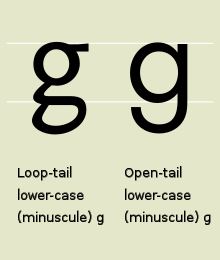Allograph
In graphemics, an obvious example in English (and many other writing systems) is the distinction between uppercase and lowercase letters.The letter g, for example, has two common forms in different typefaces, and a wide variety in people's handwriting.A positional example of allography is the long s |ſ|, a symbol which was once a widely used as a non-final allograph for the lowercase letter s. A grapheme variant can acquire a separate meaning in a specialized writing system, such as the International Phonetic Alphabet used in linguistics.Typically, for example, U+0067 g LATIN SMALL LETTER G is given a loop tail in serif typefaces but not in sans-serif faces (e.g., Times New Roman: g, Helvetica: g) but its code point is constant and its meaning persists irrespective of typeface.For instance: The concept of the allograph may be compared and contrasted with that of the homoglyph – glyphs of different meaning that are visually similar.
Garshunographygraphemicstypographygraphemeuppercase and lowercasetypefaceshandwritinglong swriting systemInternational Phonetic Alphabetlinguisticscode pointsUnicodeeuro signglyphscode pointsans-serifVariant Chinese charactersHan scriptMainland ChinaTaiwanhomoglyphAllophoneHan unificationCoptic scriptArabic scriptIPA Extensions